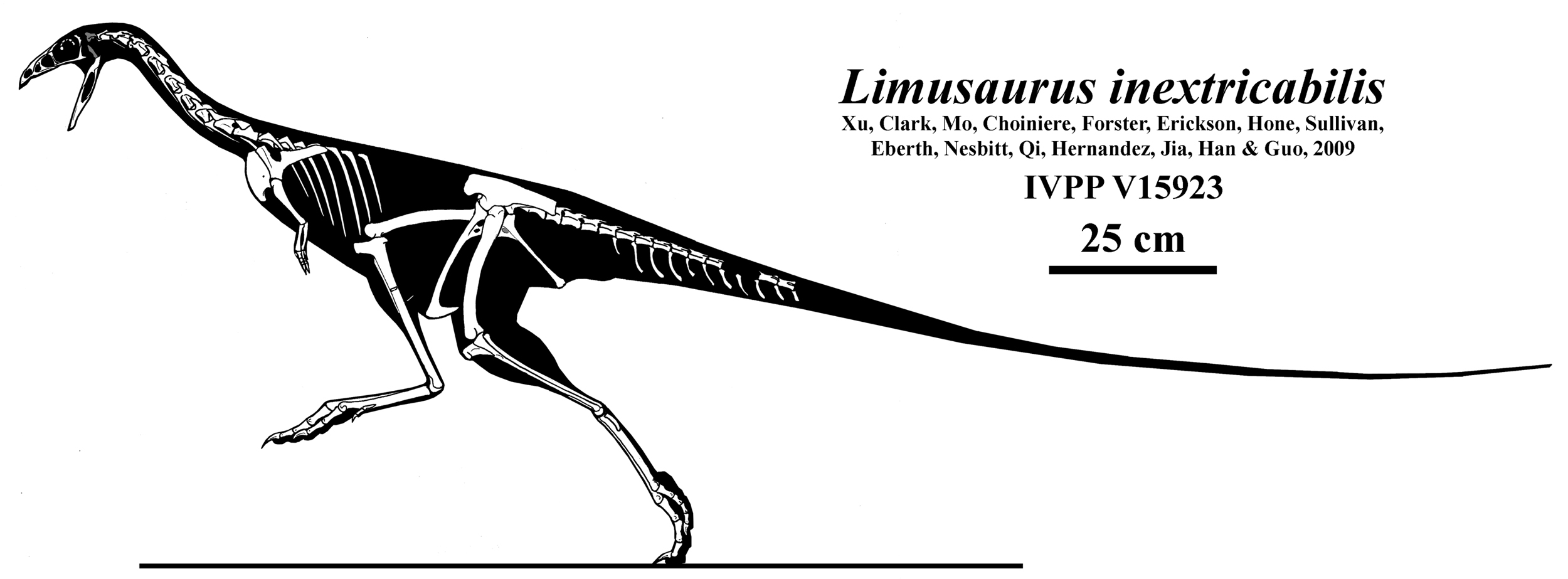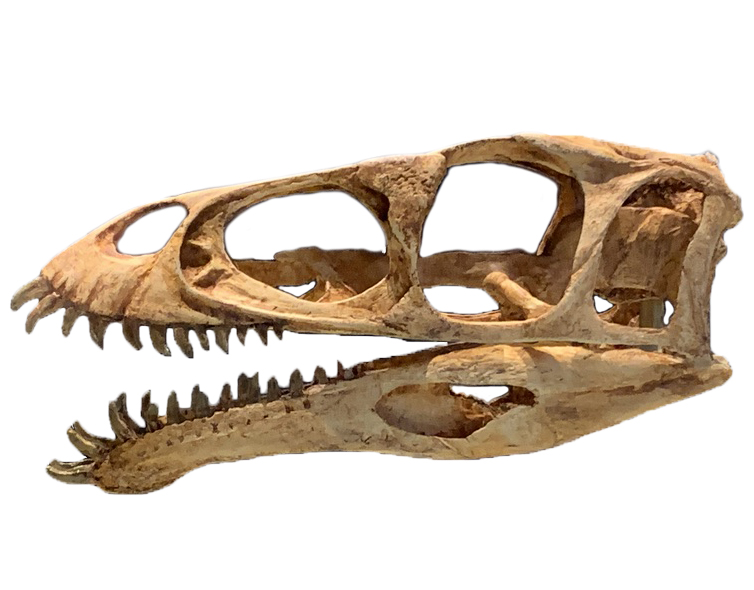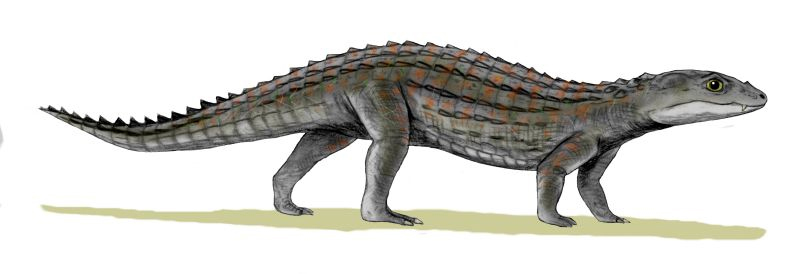|
Velocisaurus
''Velocisaurus'' ("swift lizard") is a genus of noasaurid theropod dinosaur from the Late Cretaceous period of Argentina. Description ''Velocisaurus'' was probably around long, based on a tibia length of . This makes it the smallest noasaurid, after ''Berthasaura''. The foot is unique in that the middle (third) metatarsal has become the main weight-bearing element. Its upper end has thickened whereas the shafts of the adjoining second and fourth metatarsals have thinned considerably. Such a configuration is unknown for other theropods, including birds. Bonaparte explained it as an adaptation for a cursorial (running) lifestyle. The high speed would have been necessary to escape larger theropods; Bonaparte suggested that ''Velocisaurus'' was itself an omnivore, as indicated by the fact that the sole claw found, of the fourth toe, was not trenchant but relatively straight. ''Velocisaurus'' can be characterized by several traits unknown in other Abelisauroids. These include: * ... [...More Info...] [...Related Items...] OR: [Wikipedia] [Google] [Baidu] |
Velocisaurus
''Velocisaurus'' ("swift lizard") is a genus of noasaurid theropod dinosaur from the Late Cretaceous period of Argentina. Description ''Velocisaurus'' was probably around long, based on a tibia length of . This makes it the smallest noasaurid, after ''Berthasaura''. The foot is unique in that the middle (third) metatarsal has become the main weight-bearing element. Its upper end has thickened whereas the shafts of the adjoining second and fourth metatarsals have thinned considerably. Such a configuration is unknown for other theropods, including birds. Bonaparte explained it as an adaptation for a cursorial (running) lifestyle. The high speed would have been necessary to escape larger theropods; Bonaparte suggested that ''Velocisaurus'' was itself an omnivore, as indicated by the fact that the sole claw found, of the fourth toe, was not trenchant but relatively straight. ''Velocisaurus'' can be characterized by several traits unknown in other Abelisauroids. These include: * ... [...More Info...] [...Related Items...] OR: [Wikipedia] [Google] [Baidu] |
Velocisauridae
Noasauridae is an extinct family of theropod dinosaurs belonging to the group Ceratosauria. They were closely related to the short-armed abelisaurids, although most noasaurids had much more traditional body types generally similar to other theropods. Their heads, on the other hand, had unusual adaptations depending on the subfamily. 'Traditional' noasaurids, sometimes grouped in the subfamily Noasaurinae, had sharp teeth which splayed outwards from a downturned lower jaw. The most complete and well-known example of these kinds of noasaurids was ''Masiakasaurus knopfleri'' from Madagascar. Another group, Elaphrosaurinae, has also been placed within Noasauridae by some studies. Elaphrosaurines developed toothless jaws and herbivorous diets, at least as adults. The most complete and well known elaphrosaurine was ''Limusaurus inextricabilis''. At least some noasaurids had pneumatised cervical vertebrae.Arthur Souza Brum, Elaine Batista Machado, Diogenes de Almeida Campos & Alexa ... [...More Info...] [...Related Items...] OR: [Wikipedia] [Google] [Baidu] |
Noasauridae
Noasauridae is an extinct family of theropod dinosaurs belonging to the group Ceratosauria. They were closely related to the short-armed abelisaurids, although most noasaurids had much more traditional body types generally similar to other theropods. Their heads, on the other hand, had unusual adaptations depending on the subfamily. 'Traditional' noasaurids, sometimes grouped in the subfamily Noasaurinae, had sharp teeth which splayed outwards from a downturned lower jaw. The most complete and well-known example of these kinds of noasaurids was ''Masiakasaurus knopfleri'' from Madagascar. Another group, Elaphrosaurinae, has also been placed within Noasauridae by some studies. Elaphrosaurines developed toothless jaws and herbivorous diets, at least as adults. The most complete and well known elaphrosaurine was ''Limusaurus inextricabilis''. At least some noasaurids had pneumatised cervical vertebrae.Arthur Souza Brum, Elaine Batista Machado, Diogenes de Almeida Campos & Alexa ... [...More Info...] [...Related Items...] OR: [Wikipedia] [Google] [Baidu] |
Abelisaur
Abelisauroidea is typically regarded as a Cretaceous group, though the earliest abelisauridae remains are known from the Middle Jurassic of Argentina (classified as the species Eoabelisaurus mefi) and possibly Madagascar (fragmentary remains of an unnamed species) possible abelisauridae remains (an isolated left tibia, right femur, and right tibia) were also discovered in Late Jurassic Tendaguru Beds in Tanzania. Abelisauroids flourished in the Southern hemisphere during the Cretaceous period, but their origins can be traced back to at least the Middle Jurassic, when they had a more global distribution (the earliest known abelisauroid remains come from Australian and South American deposits dated to about 170 million years ago). By the Cretaceous period, abelisauroids had apparently become extinct in Asia and North America, possibly due to competition from tyrannosauroids. However, advanced abelisauroids of the family Abelisauridae persisted in the southern continents until ... [...More Info...] [...Related Items...] OR: [Wikipedia] [Google] [Baidu] |
José Bonaparte
José Fernando Bonaparte (14 June 1928 – 18 February 2020) was an Argentine paleontologist who discovered a plethora of South American dinosaurs and mentored a new generation of Argentine paleontologists . One of the best-known Argentine paleontologists, he has been described by paleontologist Peter Dodson as "almost singlehandedly ... responsible for Argentina becoming the sixth country in the world in kinds of dinosaurs". Biography Bonaparte was the son of an Italian sailor, with no close connection to Napoleon's House of Bonaparte. He was born in Rosario, Santa Fe, Argentina, and grew up in Mercedes, Buenos Aires. Despite a lack of formal training in paleontology, he started collecting fossils with many friends at an early age, and created a museum in their home town. He later became the curator of the National University of Tucumán, where he was named ''Doctor Honoris causa'' in 1976, and then in the late 1970s became a senior scientist at the Museo Argentino de Cienci ... [...More Info...] [...Related Items...] OR: [Wikipedia] [Google] [Baidu] |
Masiakasaurus
''Masiakasaurus'' is a genus of small predatory noasaurid theropod dinosaurs from the Late Cretaceous of Madagascar. In Malagasy, ''masiaka'' means "vicious"; thus, the genus name means "vicious lizard". The type species, ''Masiakasaurus knopfleri'', was named after the musician Mark Knopfler, whose music inspired the expedition crew. It was named in 2001 by Scott D. Sampson, Matthew Carrano, and Catherine A. Forster. Unlike most theropods, the front teeth of ''M. knopfleri'' projected forward instead of straight down. This unique dentition suggests that they had a specialized diet, perhaps including fish and other small prey. Other bones of the skeleton indicate that ''Masiakasaurus'' were bipedal, with much shorter forelimbs than hindlimbs. ''M. knopfleri'' was a small theropod, reaching long and weighing . ''Masiakasaurus'' lived around 70 million years ago, along with animals such as ''Majungasaurus'', ''Rapetosaurus'', and ''Rahonavis''. ''Masiakasaurus'' was a member o ... [...More Info...] [...Related Items...] OR: [Wikipedia] [Google] [Baidu] |
Bajo De La Carpa Formation
The Bajo de la Carpa Formation is a geologic formation of the Neuquén Basin that crops out in northern Patagonia, in the provinces of Río Negro and Neuquén, Argentina. It is the oldest of two formations belonging to the Río Colorado Subgroup within the Neuquén Group. Formerly, that subgroup was treated as a formation, and the Bajo de la Carpa Formation was known as the Bajo de la Carpa Member.Sánchez ''et al.'', 2006 At its base, this formation conformably overlies the Plottier Formation of the older Río Neuquén Subgroup, and it is in turn overlain by the Anacleto Formation, the youngest and uppermost formation of the Neuquén Group. The Bajo de la Carpa Formation can reach in thickness in some locations, and consists mainly of sandstones of various colors, all of fluvial origin, with thin layers of mudstone and siltstone in between. Geological features such as geodes, chemical nodules, impressions of raindrops, and paleosols (fossil soils) are commonly found in this ... [...More Info...] [...Related Items...] OR: [Wikipedia] [Google] [Baidu] |
Abelisauridae
Abelisauridae (meaning "Abel's lizards") is a family (or clade) of ceratosaurian theropod dinosaurs. Abelisaurids thrived during the Cretaceous period, on the ancient southern supercontinent of Gondwana, and today their fossil remains are found on the modern continents of Africa and South America, as well as on the Indian subcontinent and the island of Madagascar. Isolated teeth were found in the Late Jurassic of Portugal, and the Late Cretaceous genera '' Tarascosaurus'' and ''Arcovenator'' have been described in France. Abelisaurids first appear in the fossil record of the early middle Jurassic period, and at least two genera (the Moroccan ''Chenanisaurus'' and the Madagascan ''Majungasaurus'') survived until the end of the Mesozoic era 66 million years ago. Like most theropods, abelisaurids were carnivorous bipeds. They were characterized by stocky hind limbs and extensive ornamentation of the skull bones, with grooves and pits. In many abelisaurids, such as ''Carnotaurus'', ... [...More Info...] [...Related Items...] OR: [Wikipedia] [Google] [Baidu] |
Berthasaura
''Berthasaura'' (meaning "Bertha's lizard") is a genus of noasaurid ceratosaurian theropod dinosaur from the Cretaceous Goio-Erê Formation of Paraná, Brazil. The type and only species is ''Berthasaura leopoldinae''. Discovery and naming Between 2011 and 2015, paleontologists working at the Cemitério dos Pterossauros site near Cruzeiro do Oeste discovered the skeletons of the pterosaurs ''Caiuajara'' and ''Keresdrakon'' as well as remains of small theropods. One of these was in 2019 named and described as ''Vespersaurus'' but a second species proved to be present. In 2021, the type species ''Berthasaura leopoldinae'' was named and described by Geovane Alves de Souza, Marina Bento Soares, Luiz Carlos Weinschütz, Everton Wilner, Ricardo Tadeu Lopes, Olga Maria Oliveira de Araújo and Alexander Wilhelm Armin Kellner. The generic name ''Berthasaura'' refers to the scientist and women's rights activist Bertha Maria Júlia Lutz, while the specific name honors Maria Leopoldina, ... [...More Info...] [...Related Items...] OR: [Wikipedia] [Google] [Baidu] |
Oscar De Ferrariis
Oscar, OSCAR, or The Oscar may refer to: People * Oscar (given name), an Irish- and English-language name also used in other languages; the article includes the names Oskar, Oskari, Oszkár, Óscar, and other forms. * Oscar (Irish mythology), legendary figure, son of Oisín and grandson of Finn mac Cumhall Places * Oscar, Kentucky, an unincorporated community * Oscar, Louisiana, an unincorporated community * Oscar, Missouri, an unincorporated community * Oscar, Oklahoma, an unincorporated community * Oscar, Pennsylvania, an unincorporated community * Oscar, Texas, an unincorporated community * Oscar, West Virginia, an unincorporated community * Lake Oscar (other) * Oscar Township, Otter Tail County, Minnesota, a civil township Animals * Oscar (bionic cat), a cat that had implants after losing both hind paws * Oscar (bull), #16, (d. 1983) a ProRodeo Hall of Fame bucking bull * Oscar (fish), ''Astronotus ocellatus'' * Oscar (therapy cat), cat purported to predict ... [...More Info...] [...Related Items...] OR: [Wikipedia] [Google] [Baidu] |
Zulma Brandoni De Gasparini
Zulma Nélida Brandoni de Gasparini (born 15 May 1944) is an Argentinian paleontologist and zoologist. She is known for discovering the fossils of the dinosaur ''Gasparinisaura'', which was named after her. Work Born in the city of La Plata, Argentina on 15 May 1944, Brandoni de Gasparini graduated in zoology from the National University of La Plata in 1966 and obtained her PhD in Natural Sciences in 1973. Zulma Brandoni de Gasparini was internationally recognized in the nineties for leading the team that discovered the Gasparinisaura. She is a recognized expert in Mesozoic reptilians of South America. In 1972, she started her scientific career at the CONICET, in which was promoted in 2003 to the grade of ''Superior Researcher''. She is today professor in Paleontology of Vertebrates in the National University of La Plata. Honours Brandoni de Gasparini has been awarded, among others recognitions, the Prize "Bernardo Houssay" of the CONICET (1987), the Prize to the Merit of ... [...More Info...] [...Related Items...] OR: [Wikipedia] [Google] [Baidu] |
Patagonia
Patagonia () refers to a geographical region that encompasses the southern end of South America, governed by Argentina and Chile. The region comprises the southern section of the Andes Mountains with lakes, fjords, temperate rainforests, and glaciers in the west and deserts, tablelands and steppes to the east. Patagonia is bounded by the Pacific Ocean on the west, the Atlantic Ocean to the east, and many bodies of water that connect them, such as the Strait of Magellan, the Beagle Channel, and the Drake Passage to the south. The Colorado and Barrancas rivers, which run from the Andes to the Atlantic, are commonly considered the northern limit of Argentine Patagonia. The archipelago of Tierra del Fuego is sometimes included as part of Patagonia. Most geographers and historians locate the northern limit of Chilean Patagonia at Huincul Fault, in Araucanía Region.Manuel Enrique Schilling; Richard WalterCarlson; AndrésTassara; Rommulo Vieira Conceição; Gustavo Walter Bertotto; ... [...More Info...] [...Related Items...] OR: [Wikipedia] [Google] [Baidu] |



.jpg)


